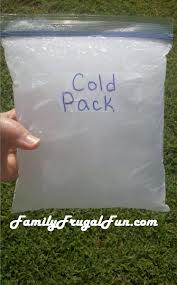Spring is here!
As the days get warmer, the more running, jumping, kicking, and active play will happen out-of-doors… without the layer upon layer of outerwear.
We are soooo happy! (And all the children {AND their mothers} said “Yippee!”.)
With the increase of activity (and the decrease of padded clothing) comes a greater potential for injury. So let’s not begin to fret and worry; let’s just be prepared by making an ICE PACK… ahead of time. Just in case! It’s very simple and it only uses two ingredients: rubbing alcohol and water.
Homemade Ice Pack Recipe:
Combine one part rubbing alcohol with three parts water.
Place in a one-gallon zip lock bag. Seal tightly. Place this bag into another one-gallon zip lock. (In other words, double bag it!).
Lay it flat in the freezer for 3 hours and it will turn to gel. It gets really cold but it’ll never harden!
When in need, place the ice pack over a warm, damp cloth on the skin for 10 – 20 minutes at a time. When finished, place it back in the freezer until it’s needed again. (It takes about 1 hour to refreeze it.)
*******************************
Now, it’s confession time. I am NOT a medical doctor and I will not be giving you medical advice today. I am simply sharing a recipe for a homemade ice pack. {In other words, I am NOT qualified to tell you when to use (or NOT use) the aforementioned ice pack!!!}
However, I do have a wonderful book written by one of America’s leading pediatricians and I will now quote him in his book “How to Raise a Healthy Child…” In a section titled ‘Sprains, Strains, and Fractures’ Dr. Robert S. Mendelsohn, M.D. states:
The bone and muscle structure in children differs significantly from that of adults, and this affects the type of injury that occurs to arms and legs. Sprains, which involve the tearing or stretching of a ligament, are seldom seen in young children because the ligaments are not yet firmly attached to the bone. Growing children are more likely to suffer damage to the epiphysis, which is the soft end of the bone where growth occurs. If your child twists his wrist, knee, or ankle, and the swelling and pain persist for two days or more, see a doctor because, if it is a fracture of the epiphysis, it requires casting…
If your child suffers a leg injury from twisting an ankle or a knee, there is no need to seek medical attention immediately. Delaying for a couple of days to see if the pain and swelling subside will not impede the treatment, if the injury proves to be a fracture and medical help must be sought. Encourage your child to keep his weight off the injured member and apply ice packs to the injured area to reduce the swelling. This will cease to be of value after an hour or so, and many doctors recommend that heat then be applied to improve the circulation in the injured member.
I should note, in all candor, that this is one of the many situations in which the “science” of medicine is less than precise. There is vast disagreement over whether the application of cold or the application of heat is the best treatment for a sprained ankle… no one really know which works best for sprained ankles – heat or cold. The important thing is to immobilize the ankle and wrap it with an elastic bandage to prevent motion that will aggravate the injury. Just be sure that the bandage is not applied so tightly that it cuts off circulation. Don’t listen to anyone who tells you that the best treatment for a sprain is to have your child walk on it at once. Pain is nature’s way of telling you that something is wrong, so if your child’s ankle hurts, the message is “keep off!”
Later in the book, Dr. M mentions that it is estimated that about 98% of the x-rays ordered for arm and leg injuries for children do not reveal a fracture, so it is obvious that many are ordered frivolously. Waiting two days, and using common sense, seems prudent. However, as stated earlier, I am not giving you any medical advice. You are solely responsible for the health care decisions of your own child. I just hope the ice pack comes in handy sometime. Because it’s perfect for wrapping around bumps, bruises, aches & pains! And it is such a cinch to make!














